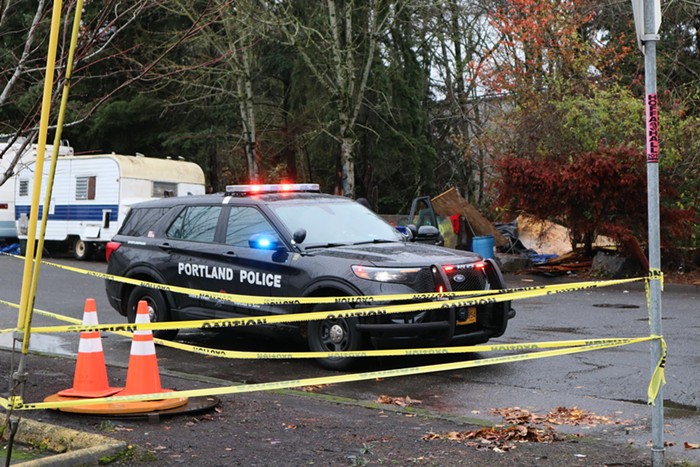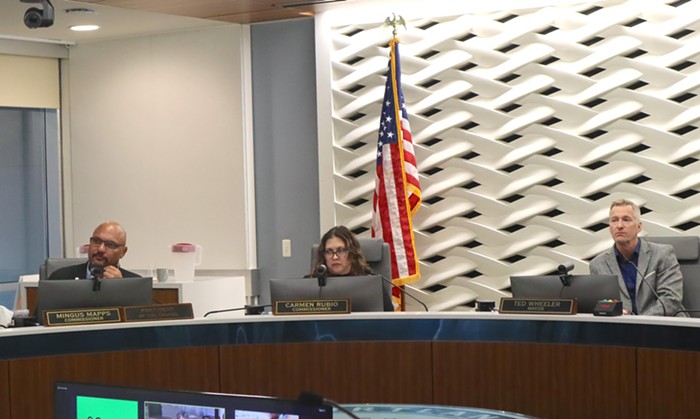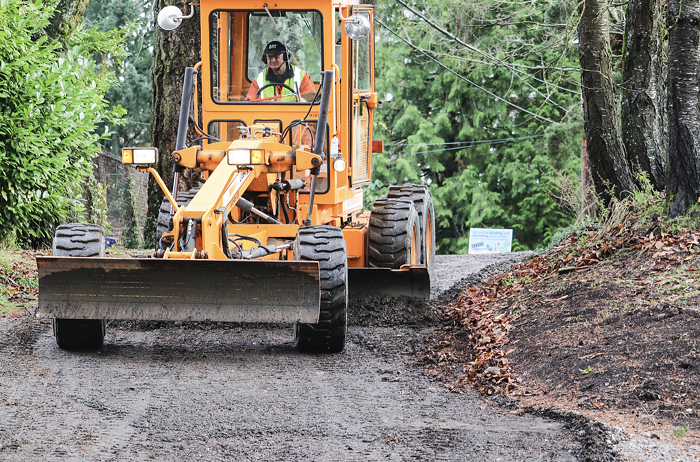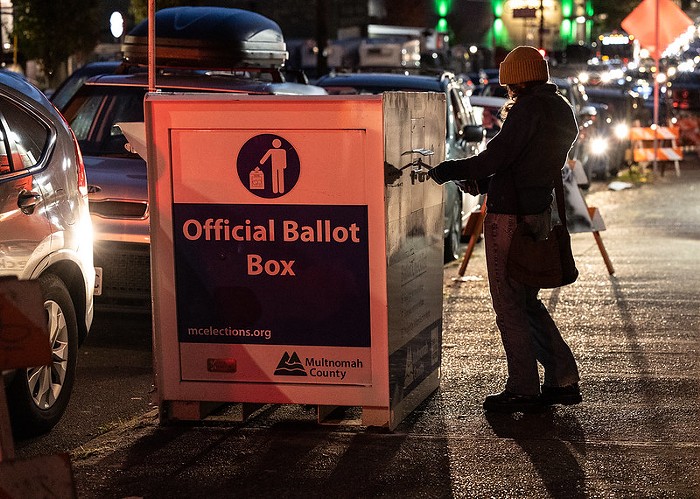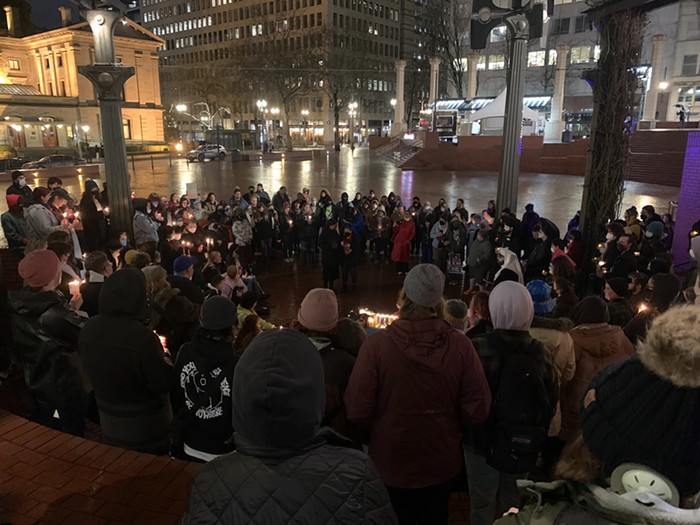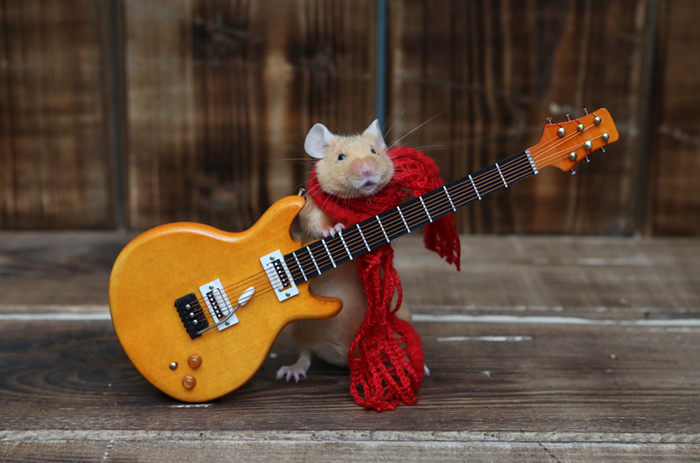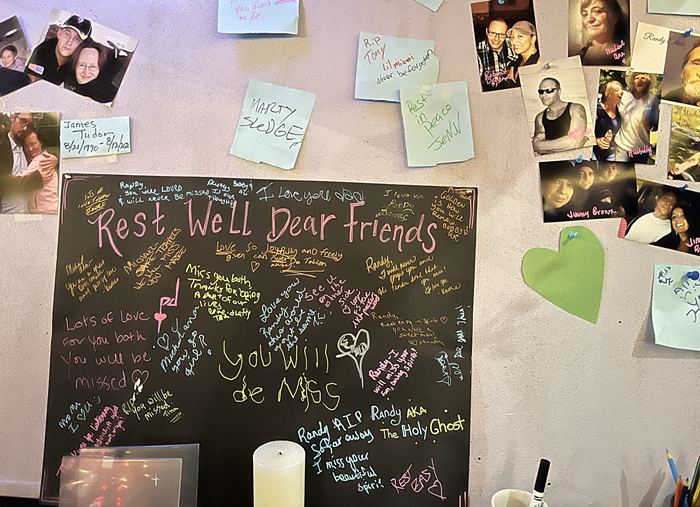The scene on Monday and Wednesday nights at the Oregon National Guard Armory is a high-octane blend of righteous babes, bruised thighs, and flying elbows. It's a Rose City Rollers (RCR) practice session, where the fledgling roller derby team gathers to sharpen their sprinting, slingshotting, jamming, and showmanship skills.
Nearly 40 girls with names like Cutthroat Curly, Paradise Kitty, Fire Crotch, and Miso Deadly sit on the Armory's cement floor, lacing up their skates and strapping on pads. Sporting ripped Misfits T-shirts, helmets plastered with Thrasher stickers, spiked wristbands, miniskirts, and old-school four-wheel skates, the Rollers create a peculiar blend of girlie and butch.
Between swapping war stories about the previous night's bar hopping and comparing injury reports, they ask how they look in their new uniforms, chat cattily about other players, and share socket sets as they tighten the trucks on their skates. Pausing to lend sympathies to the injured skaters who have to sit out practice (broken thumb, torn knee cartilage), the girls begin warm-up laps around the empty gymnasium.
THE UNFORGIVING SPORT
The Rose City Rollers were born in August 2004, when Portland skaters Kim Stegeman and Jeffrey Wonderful sat around a bar in Southeast Portland discussing the recently revived sport. After a few nights of increasing enthusiasm, the pair began researching the movement online, seeing what leagues like the Texas Rollergirls were up to, and brushing up on how the game was played. A small group began to skate at Mount Scott Community Center, learning the ropes as they went along. Novice skaters would ask Stegeman and Wonderful questions about rules and techniques, and the two of them would improvise answers while becoming more absorbed in the game through online forums and talking to women who skated in derbies years ago. The learning curve was steep, as the Rollers quickly became organized and began to register team names and look for a permanent home. (The search for a RCR headquarters proved to be exceptionally difficult, given the growing property values in Portland. The league still has no dedicated space to call home, hold practices, or host competitions—they don't even have lockers.) The Rollers briefly practiced in the basement of SE bowling alley Grand Central Bowl, and were homeless for several months before landing their part-time practice space at the Armory.
The number of girls who signed up over time grew wildly—Stegeman claims there have been hundreds—though most don't stick around for the long haul. Roller derby is an aggressive sport—girls have been injured at nearly every practice I've attended. The cement floor of the Armory is an unforgiving surface, and the game lends itself to sprained ankles, torn ligaments, and the occasional broken bone.
Last Monday's practice found the Rollers more high-strung than I had ever seen them. It was one of the last practices before their first public bout at the Portland Expo Center this Saturday, October 22. This is what the girls have been working toward for the past three years; although they've made public appearances here and there, nobody has seen what the Rose City Rollers can do. The teams, many geared up in their uniforms for the first time, nervously huddled around as they worked on their entrances, which find the girls skating in a complex, multi-directional blur of helmets, tattoos, and dreadlocks to the Rose City Rollers' punk theme song.
Lending historic significance to Saturday's bout, the Portland Expo Center is where Raquel Welch starred in the 1972 roller derby flick Kansas City Bomber. Stegeman assures me that audiences can expect a completely different game on Saturday.
"That was banked-track derby," she says, "and almost everybody plays on flat-track now. There's actually a lady on our team who played from '59 to '63 on actual banked-track derby with the [legendary San Francisco league] Bay City Bombers. Back then, the outcomes were all predetermined, and a lot of the action was choreographed. We don't do that, obviously. It's a totally different beast."
THE RISE, FALL, AND RISE OF ROLLER DERBY
In the Depression, mass entertainment was almost as lame as today's reality television craze. Flagpole sitting and phone-booth stuffing gave way to dance marathons, and eventually to roller skate marathons. Roller derby was officially born in 1935 at the Chicago Coliseum, with over 20,000 viewers in attendance. Leo Seltzer, the Vince McMahon of his day, organized a monumental skate endurance competition in which teams skated 4,000 miles—roughly the distance from New York to Los Angeles.
Seltzer and a New York sportswriter later noticed that the game was most interesting when the participants would get tangled up or use aggressive tactics to gain the lead position. Savvy promoter that he was, Seltzer made violence an integral part of the game, and roller derby was born. Roller derby was still thriving when TV mania hit the country in the 1950s, and the craze only expanded when matches from San Francisco's Bay City Bombers reached millions of living rooms across the country. By the 1970s, the sport had fizzled out and for the subsequent 30 years, suffered a series of failed rebirths, including the televised Rollergames, which featured alligator pits and commentary by late-night wackjob Wally George.
In the past few years, though, roller derby has become super hot again, thanks in no small part to the fact that it's being played by super-hot chicks. Punk and indie girls across the country are forming their own leagues on a near-monthly basis. With the Texas Rollergirls and Gotham City Roller Derby as guiding saints, leagues have cropped up in cities like Seattle, Kansas City, Raleigh, New Orleans, and just about every other half-decent city in the country.
SPINNING WHEELS AND BUSTED TEETH
For all its WWE-style showmanship, roller derby is no longer a scripted exhibition game. Winners are determined by points scored; each team has five rollers on the track at once. The lead roller is called the pivot; pivots set the pace for the game's action. Behind them are blockers, who roll in packs of three. The jammer is sort of the quarterback and running back all in one. After the pivots and blockers take off, each team's jammer attempts to surpass the entire group, taking plenty of elbow jabs and hip checks along the way. Once they skate through the whole pack, lap the group, and make their way back into the mayhem, they are awarded points for every member of the opposing team they pass. Along the way, skates often tangle together, creating pileups, and competitive defenses frequently give way to fouls and flared tempers.
At last Monday's practice, it was startling to see how much the Rollers had improved since I first watched their practices months ago. Back then many of the girls were still obviously hesitant on their skates, making unsure attempts at skating backward and slingshotting past each other to gain speed. Last week all their tentativeness seemed to have disappeared. After breezing through a few practice laps, the girls would knee slide back into their corners, slap their asses while cruising past one another at breakneck speeds, and teasingly shove and cut one another off without creating a four-girl pileup.
Although one or two confessed to having serious stagefright, they seemed collectively charged to take the Expo Center by storm Saturday night, as well as the future of roller derby in Portland.
"I'm awestruck sometimes by the sheer magnitude this has grown into in one year," Stegeman tells me. "I'm looking forward to having full seasons, playing on a national circuit—all the while keeping the action going here in Portland. But first we've got to worry about getting through Saturday night... and kicking some ass out there."
Rose City Rollers' First Roller Derby Bout, Portland Expo Center, Hall C, Sat Oct 22, doors open at 5 pm, bout begins at 6 pm, $10
